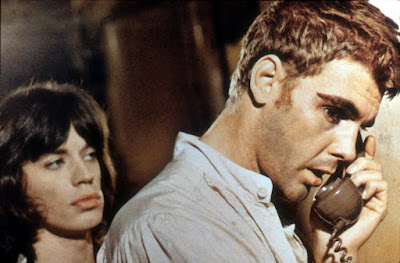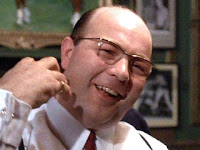 |
| Brad Pitt and Mike Moh, 'Once Upon a Time in Hollywood.' |
Ever since it hit the screen in 2019 there’s been a lot of talk about Quentin Tarantino’s “Once Upon a Time … In Hollywood,” especially the fight scene between stuntman Cliff Booth (Brad Pitt) and martial arts master and actor Bruce Lee (Mike Moh). Their fictitious on-screen dustup ruffled some feathers, particularly among Lee’s kin and the actor’s fans, who say that he was unfairly maligned. On the surface, the fight scene does makes Lee out to be a delusional windbag. While Moh’s portrayal is decidedly bizarre and probably a highly exaggerated portrait of Lee, Tarantino’s intention, I think, is not to disrespect Lee but to make us wonder about the reliability of Cliff’s recollections of events and to cast doubt on whether or not certain events actually took place.
We see the scene filtered through Cliff’s recollection of it, which makes us wonder if he merely remembers Lee in the least flattering terms possible because of animosity between the two. Some say that the real Bruce Lee had a rough relationship with movie stuntmen, whom he didn’t respect. Rumor has it that he’d intentionally hit stunt actors rather than pull his punches, leading some to refuse to work with the actor.
Cliff and Lee’s fight, a sparring match, actually, is seen in flashback. And to make matters all the more complicated, it’s followed by yet another flashback. The sequence starts when Cliff is fixing a rooftop TV antenna for his buddy and employer, TV star Rick Dalton (Leonardo DiCaprio). His mind wanders to an encounter with Lee on the set of TV series “The Green Hornet” (1966-’67). In the flashback, Cliff, nattily dressed in a tuxedo and wearing a silly pompadour hairpiece, gets into a verbal scrap with Lee, who happens to be the show’s co-star. Lee is holding court with a gaggle of fawning crew members, and proclaims that he could beat Cassius Clay (Muhammed Ali) in a fight. Cliff snickers, and that leads to a round of fisticuffs; two falls out of three wins it; no hitting in the face. Before the action starts someone clues Lee into the rumor that Cliff murdered his wife, which gives the confident martial artist a moment’s pause. Things come to a head when Cliff deflects Lee’s kick and sends the martial artist careening into a parked Lincoln Continental, leaving a huge dent in the body. Stuntman Randy (Kurt Russell) fires Cliff for messing with the actor and damaging the vehicle.
While this seems like straightforward storytelling there are strange and subtle activities percolating in the background. Crew members sit comfortably as they take in the action. But just before Lee is tossed into the car the spectators are suddenly gone. It seems like a continuity error in editing the film, not unlike those that were intentionally placed in Tarantino’s “Grindhouse” (2007), where Tarantino mimicked sloppy mistakes endemic in cheapo grindhouse exploitation films of the 1960s and ’70s. But, in “Once Upon a Time … in Hollywood” the disappearing spectators suggest we’re seeing a highly subjective recollection of the facts, or perhaps a total fabrication of events. And, what about that smashed car door? It’s a big, gaping dent, as if the car was hit by a slow-moving 18-wheeler. The impact would surely be enough to kill a man.
Odder still is the flashback within a flashback, in which Cliff remembers himself on a boat with his now dead wife. She’s lambasting him about their crappy vessel among other things. Cliff sits impassively, a spear fishing gun in his hands. Did the browbeaten husband finally snap and skewer his furious wife? Their tense encounter on the ocean reminds us of a real-life Hollywood death when actress Natalie Wood drowned under suspicious circumstances while yachting with her husband Robert Wagner. The sequence ends, and Cliff does not fire a spear at his beloved, but we can’t help but suspect it’s on his “things to do” list.
When the flashback sequences end, things get weirder still as Cliff, still on the rooftop, notices a scruffy, bearded dude down below on the street — Charles Manson, as it turns out, who has just paid a call on the home next door. Manson gives Cliff a big smile and a courtly wave (howdy, partner) to which Cliff looks on with suspicion. His instincts about the weird little character would prove prescient — the house next door is the residence of actress Sharon Tate and director Roman Polanski and was the scene of one of the most notorious multiple murders in the city’s history.
That encounter weighs heavily on us as we watch the story continue to unfold, expecting the worst, holding our breath, and waiting for the inevitable. But, as anyone who’s seen “Inglourious Basterds” (2009) knows, Tarantino has a way of playing with historical facts when he weaves fictional threads into his non-fictional tapestry. And just as we can’t really be sure about the veracity of Cliff’s encounters, factually, Tarantino’s tale of Hollywood at a historic crossroad is a malleable as wet papier mâché. In the end, “Once Upon a Time … in Hollywood” is a fairytale. Not the kind you’d read to kids at bedtime, but a nostalgia-tinged farewell to a time and place that now exists mostly in our highly unreliable memories.






















